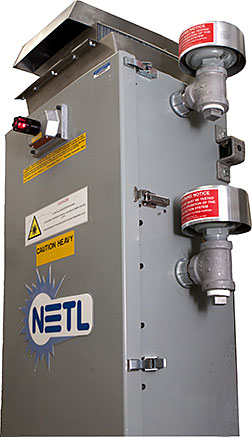- Number 405 |
- January 20, 2014
Raman gas sensor provides real-time gas composition analysis

The Raman gas sensor is ideal for
conducting quick and continuous
measurements of gaseous streams in
a pipeline or industrial facility.
Improving the efficiency of our nation’s power plants is a key focus area of the National Energy Technology Laboratory (NETL) research efforts. Even small increases in process efficiency can result in improved energy output and reduce the environmental impacts associated with the use of fossil fuels. A new gas composition sensor developed by researchers at NETL and the University of Pittsburgh, under the NETL-Regional University Alliance program, aims to improve the process efficiency of gas-fired power generating facilities.
Natural gas, the most common gas fuel, can have significant variations in hydrocarbon composition depending on the source. Opportunity fuels such as biogas and landfill gases also have significant variation in quality, and operators often use natural gas as a backup. All of these gases differ in their BTU content, flame speed, Wobbe Index, dilution gases, and composition. Modern lean-burning, low-emission gas turbines and reciprocating engines require fine-tuned control of the combustion process to achieve optimal operation. Fluctuations in fuel gas composition can result in reduced efficiency, high pollutant emissions, and turbine damage. Real-time fuel gas composition sensing would enable a turbine control system to adjust rapidly and maintain optimal combustion conditions.
Recognizing the need for a sensing system that can quickly and reliably identify, characterize, and determine the concentration of various gases in a gas mixture, Drs. Michael Buric and Steven Woodruff, research scientists at NETL, and their academic colleagues pursued a line of experimentation over a number of years that ultimately resulted in the development of a patented real-time Raman gas composition analyzer.
The new sensor is based on Raman spectroscopy and uses state-of-the-art optical waveguides, solid state lasers, and compact spectrometers to reduce the size and increase the sensitivity above state-of-the-art spectroscopic systems to give readouts in one second or less. The combination of speed, accuracy, and multiple species measurement makes the gas detection system well-suited for improving control of natural- gas-fired turbines by measuring the input-fuel composition or filtered exhaust gases in real time. This sensor will greatly benefit the power industry, as well as other industries utilizing gaseous input or output streams by enabling smarter control to increase process efficiency and reduce emissions. In addition to saving on fuels costs, adoption of this technology will help reduce greenhouse gas emissions.
According to Dr. Buric, “The sensing of gaseous components can be determined by a number of methods, most commonly by gas chromatography or absorption spectroscopy. These methods are reliable but take a longer time to make the measurement and return data. The new sensor overcomes that limitation by providing real-time results.”
The novel gas sensor system provides an accurate and continuous readout of the relative mole percent of all major fuel-gas components, including hydrogen, carbon monoxide, carbon dioxide, methane, ethane, and propane, along with oxygen, nitrogen, and water.
The team subsequently developed a prototype analyzer that was field tested through a cooperative research and development agreement with GE Energy. Following successful field testing, a United States-based instrument manufacturer licensed this technology for commercial use. Dr. Woodruff commented, “We made a concerted outreach effort to engage our industry partners in field testing and licensing opportunities. Transferring advanced technologies into the commercial market space is always incredibly satisfying for applied researchers and we look forward to seeing new commercial products incorporating the Raman technology.”Submitted by DOE’s National Energy Technology Laboratory
